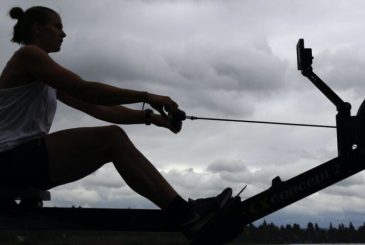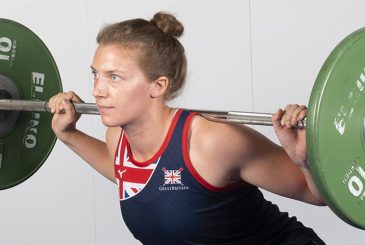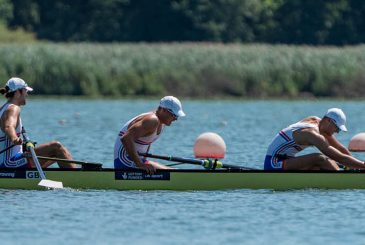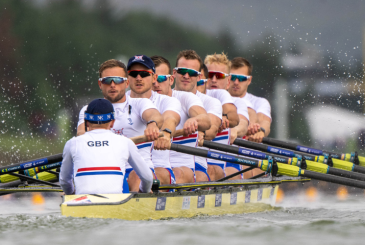Most rowing training programmes contain some form of interval training – bouts of high-intensity exercise, separated by recovery periods. Exercise physiologist Dr Mark Homer explores the different types of interval training, its benefits, and when and how to use it to improve boat speed.
What is interval training?
Interval training consists of bouts of high-intensity exercise, separated by recovery periods, with the aim of stressing the oxygen transport and utilisation systems to provide an effective stimulus for enhancing maximal oxygen consumption. But this is a broad term and covers several different types of high intensity work. In fact, intervals can range from seconds of maximal ‘sprinting’ to several minutes of sustained ‘hard’ (but not maximal) efforts. Sessions can last anywhere from 5-40 minutes (including recovery intervals).
Interval training within the wider training programme
Traditional rowing training models favour the ‘high volume – low intensity’ polarised or pyramidal approaches, as described here by GB coach Dan Moore. To get this right, however, it is important to understand training zones and how to know you are in the right one at the right time.
Low intensity training causes changes to the ‘peripheral’ systems that affect endurance performance, such as developing blood flow to the muscle, and the efficient breakdown of fuel (glucose and fat) – particularly at sub-maximal intensities. If combined with suitable nutrition and recovery, this element of a programme is fairly easy to get right. While this covers the 80% in the popular 80:20 training distribution models, the 20% can be more complicated to get right, and this is where interval training fits in.
Types of interval training
As discussed, intervals cam come in all shapes and sizes, but normally fit into one of the following categories:
- Sprint intervals: Up to 30 seconds of ‘all-out’ sprinting with recovery periods
- Short, high intensity intervals: Less than 60 seconds of high (but not maximal-intensity) efforts with recovery periods
- Long, high intensity intervals: Greater than 60 seconds of high (but not maximal-intensity) efforts with recovery periods
The benefits of interval training
Essentially, the shorter (and ‘harder’) the interval intensity, the more neuromuscular the adaptation evokes. Repetitive all-out sprints help develop the nervous system’s ability to send messages and to develop force in short periods of time. They also replicate the patterns of movement in sporting competition. In rowing, this translates to practicing high-rate work in preparation for racing.
As intervals get longer, the emphasis shifts towards the development of anaerobic capacity such as increased maximal rate of glycogen use and muscle/blood buffering capacity. Even longer and more controlled intervals target adaptations to the aerobic system, developing the maximal cardiac output (particularly stroke volume – the amount of blood pumped by the heart per beat), maximal ventilatory capacity, and the ability to use blood lactate as a fuel for energy production.
When and how to use interval training
What type of interval to use depends on the event distance, the time of year, and the individual athlete profile.
If preparing for a long head race or a winter 5km test, include long, high-intensity intervals such as 1km repetitions. In contrast, 2km races or sprint events would favour some time spent at flat-out intensities. While your speed over different distances will still benefit from the physiological adaptation caused by short and long intervals, the weighting should be different depending on the race.
If programmes follow the traditional 80:20 intensity distribution (low:high intensity) described above, this is likely to equate to two high intensity sessions per week. Ideally these are well separated and proceeded by a rest or light day. This is worth highlighting as tough sessions tend to be condensed into Saturday and Sunday for those with less time. Frequency of interval training sessions may be increased as competition approaches, but will should be combined with the reduced volume of a suitable taper.
For traditional rowing programmes, winter training should contain more long interval sessions, which have a cardiovascular/metabolic focus. Race-preparation session in the summer will contain shorter/sharper sessions with a neuromuscular emphasis. Variables that influence the effects of a high intensity training (HIT) session include the number of sets and repetitions, and the duration of work and rest within them. This classic article provides some guidance on how to design interval sessions of different lengths.
Individual tailoring
It is always worth considering the individual when programming HIT. For example, if the work is being done on an ergo or in single sculls, rowers who are known to struggle with recovery from high intensity work can be given reduced repetitions or increased rest intervals. Land-based sessions can also be used to help improve individual weakness with small but influential changes to a session. For example, include longer reps for those who need to work on their aerobic system, but shorter and harder reps for those who lack ‘top-end’ sprint speed.
Further factors to consider
Both long and short interval sessions need to be hard, and including them in a programme should lead to some improvement in their delivery. With this in mind, it is important to include progression over time to maintain and further adaptation. Doing the same session at the same splits for the whole season will lead to stagnation. You can tweak interval sessions easily by increasing the intensity, reps/sets or decreasing the rest – but be careful not to change the ‘type’ of intervals they are.
Interval training will burn more calories per unit of time than a low-intensity steady-state session but are generally shorter. Theories that there is an ‘after-burn’ effect – where metabolic demand is higher for an extended period after intense exercise – lack support. It is worth considering fuelling for these sessions though, as there is an increased reliance on carbohydrate and reduced use of fat due to carbohydrate’s easier breakdown when needed.
Finally, I touched on recovery earlier when discussing the distribution of intensity sessions. This is key as the time required to recuperate following hard training (particularly neuromuscular sprint efforts which evoke muscle damage) is higher than following easy training.
Conclusion
In conclusion, while HIT only makes up 20% of a traditional programme, its use is complex and the results can have a large impact (both good and bad) on performance. Take care to identify the goal of such sessions and the demands it will place on the individual as part of a wider programme.










